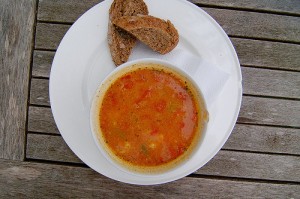Composition Cooking: How the Writing Process is Like Making Soup
 Well, it’s a new year. Colleges and high schools are getting back to business. It’s time for new classes, new activities, and—you guessed it—new writing assignments too! It’s easy, early in the semester, to push off the assignments you know are coming. It’s easy to procrastinate because the writing process looks too hard, but it doesn’t have to be that way. Believe it or not, if you can make a simple soup, you can write a paper.
Well, it’s a new year. Colleges and high schools are getting back to business. It’s time for new classes, new activities, and—you guessed it—new writing assignments too! It’s easy, early in the semester, to push off the assignments you know are coming. It’s easy to procrastinate because the writing process looks too hard, but it doesn’t have to be that way. Believe it or not, if you can make a simple soup, you can write a paper.
Step One: Browse Your Pantry
Look at potential sources. Visit the library for physical items, look at your library’s online databases, or check out other trusted material. As you browse, think about your assignment and keep a close eye on your assignment sheet if you have one. What can you make with all this that will satisfy the tastes and requests of your dinner guest (your instructor)?
Step Two: Chop and Measure
Make a plan, even if it’s just a few bullet points on a crumpled piece of paper. Do whatever you need to do to keep on track. Think about the main points you’re going to make. What are some subpoints? Do you have specific quotes or paraphrased material you know you want to include? Get those ready to go.
Step Three: Start Cooking
First draft time. Get the basics down, main ideas and support Transform your plan into a real written document.
Step Four: Liquids
Just like a soup needs broth (or some other liquid) to fill it out, a paper needs more than just a structure. Build on bones of your paper by adding more explanation and support to your points, using transitions and topic sentences and crafting an introduction and a conclusion.
Step Five: Add Spices
Read through the draft. Where can you add a little more? What needs more support? Is there another aspect to your thesis that you haven’t considered?
Step Six: Simmer
Time to trim it down. Get rid of the bulk in your sentences and leave concise language that gets to the point. Remove anything that’s off topic.
Step Seven: Plating
For this step, it’s helpful to let your soup/paper sit in the fridge overnight (or longer). Let the flavors mingle before you serve up some paper gazpacho.
When you take it out, present it nicely. Look out for typos and other errors and make sure your formatting is correct. Give it one last look. Is there anything else it needs before you serve it to your customer?
That’s It?
As anyone who’s ever tried to write a paper knows, nothing is ever “it.” Each step has its own set of challenges. How do you know what’s a strong argument? What if your professor gives you confusing directions, or worse, no directions at all? What if you’re over the word limit and don’t know where to cut? These and a thousand other questions can drive you bonkers.
Think about it this way, if you’re cooking and you don’t know how to do a step on your recipe, what do you do? Maybe you wing it, especially if you are cooking for yourself and have a backup dinner plan, but probably you seek out advice. You might ask a friend or family member, a good cook with experience in this kind of dish. You might look on the internet for the answer. When you’re stuck at a step of your paper writing process, do the same.
The internet is rife with advice, some of it good and some of it less than reliable. Look for sites run by colleges and universities or blogs devoted to writing and writing education (like this one). Instructors, writing center or tutoring professionals, and knowledgeable friends can give you one-on-one feedback. Books are also a great source.
The point is, help is out there. A chef need not go it alone. And now you have your recipe, it’s time to get cooking!
Photo Credit: Tiberiu Ana, Creative Commons